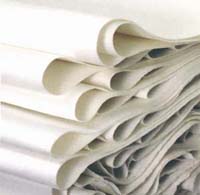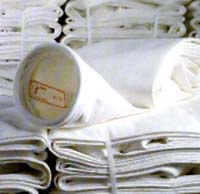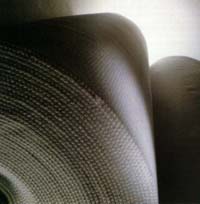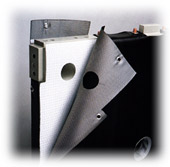
Enviro Process Engineering (HK) Co. Ltd.
安和環保工程(香港)有限公司






 |
|
Filter Fabrics - our range of fabrics for all filtering
processes. Monofilament, multifilament and fibre yarns or
combinations of these types of yarn, are the basic materials for
filter fabrics. |
 |
|||||
 |
|||||
|
Markets
- Environmental Protection |
|||||
|
Applications
- Waste water treatment and dust collectors |
The "Cloth Making" Process begins with selecting the yarns, which have specific characteristics. Fibers are produced from polypropylene, polyethylene, Nylon, polyester and Rilsan. Other materials (Kynar, PET etc.) are used for special applications.
Step 1 - FILTER CLOTH YARN DESIGNS
Multifilament or continuous filament yarns are produced by the continuous extrusion of synthetic resins. The filament bunches, which have a smooth surface are twisted together to form the yarn using an S or Z turn. Increased twisting will reduce blinding (particle retention within the yarn structure) while also decreasing collection efficiency. Multifilament yarns have high tensile strength and average particle collection efficiency. Filter cake release is average.
Monofilament yarns are single heavier extrusions. These extrusions are smooth, have high tensile strength and in some cases are modified with fillers. Monofilament yarn has excellent cake release properties and resistance to blinding. Monofilament yarns have low particle collection efficiency.
Staple (Spun) yarns are continuously extruded synthetic filaments chopped into short lengths. These short fibers are combed and twisted using a cotton or woolen manufacturing system (woolen yarn has a higher bulk). These staple (or spun) fibers have low tensile strength and a large surface area. Particle retention is excellent and cake release poor.
Step 2 - FILTER CLOTH WEAVE PATTERNS (Cloth Designs)
Plain
Is one of the most simple weave patterns. The warp and filling threads
cross alternately. Plain-woven fabrics are generally the least pliable,
but they are the most stable.
Characteristics; high particle retention and low resistance to
blinding with average cake release properties.
Twill
Is a weave characterized by a diagonal rib, or twill line. Each warp
floats over at least two or more consecutive fill yarns, enabling a
greater number of yarns per unit area than a plain weave, while not
losing a great deal of fabric stability.
Characteristics; average resistance to blinding, average cake
release, good mechanical strength.
Basket
A variation of the plain weave where two or more warp yarns cross
alternately with two or more filling yarns, resembling a plaited basket.
This weave is more pliable and stronger than a plain weave, but is
looser and not as stable. The basket weave is typically used for backing
cloth and basic filtration applications.
Leno
The leno weave is a locking type weave in which two or more warp threads
cross over each other and interlace with one or more filling threads. It
is used primarily to prevent shifting of fibers in open weave fabrics
and only for backing (support) cloths
Satin
The face of the fabric consists almost completely of warp produced in
the repeat of the weave. This is the most flexible of weave patterns and
conforms very easily around most contoured surfaces. Satin weaves are
usually four, five, eight, or twelve harness.
Characteristics; excellent cake
release, average retention, excellent resistance to blinding.
Step 3- Weaving the Cloth
Warping -
Yarn is pulled from tension controlled creels and precisely wrapped onto
warps in preparation for the loom. When positioned behind the loom the
warp yarns (which run in the length of the cloth) are inserted through
heddles. The heddles are raised and lowered to create a shed (opening)
through which the fill yarn is inserted to create the weave pattern.
Weaving -
High speed, sophisticated, computer controlled looms raise and lower the
heddles and "take up" the woven fabric, to create the geometric patterns
of our filter cloth design. The precise positioning and tensioning of
yarns creates the exact thread count (threads per inch or cm.) every
time the pattern is manufactured
Calendering
Filter cloth is stabilized in preheating machinery. Final surface finishing and permeability is achieved with high speed calenders - heated, polished, steel rolls - which press the fabric making the surface smooth and compact and further "set" the cloth.
Filter Cloths Physical Properties
Room 1019, Nan Fung Comm. Ctr., 264-298 Castle Peak Road, Tsuen Wan, N.T. Hong Kong
香港新界青山道264-298号南豐商業中心1019室
Tel 电話: (852) 2611-7376 Fax 傳真 : (852) 2617-5716 E-Mail电郵 : envirohk@netvigator.com